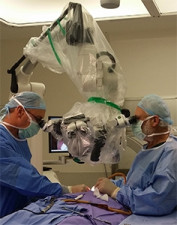
Netcare Greenacres Hospital in Port Elizabeth has installed the first Leica OH6 microscope in Africa. The microscope offers high-definition, three-dimensional visual access for microsurgery.
Leica Microsystems launched the neurosurgical microscope last year. It enables surgeons to see better into deep, narrow cavities, and is equipped with FusionOptics technology, advanced Small Angle Illumination and apochromatic optics.
Neurosurgeons Dr Jibin Francis and Dr Sajid Ansari say this technology offers a plethora of benefits for microsurgery, making surgery on tumours and aneurysms, in particular, safer and more efficient.
"This microscope has superior optics, which aids in the performance of complex, intricate operations, especially intracranial surgery," Dr Francis notes.
"It has also integrated a tumour fluorescence module for more precise differentiation of tumours from surrounding brain tissue, allowing for more complete tumour removal," Dr Ansari adds.
Ian Goble, Netcare's regional director - coastal, says the benefits for patients and surgeons alike outweigh the costs of the Leica OH6 microscope. "Also, since microsurgery is easier and more efficient with the use of this type of technology, time is saved. This is not so easy to quantify in monetary terms but we are confident the microscope will more than pay for itself."
Goble notes there is increasing demand for neurosurgical procedures at Netcare Greenacres Hospital, which has four neurosurgeons. "There are two neurosurgical theatres running at the hospital on most days and this additional piece of equipment became a necessity. The Leica OH6 is also equipped with fluorescent microscopy, which allows for more precise differentiation between tumor and surrounding brain tissue."
He points out 3D technology is far superior to traditional 2D surgical systems because it provides greater depth perception and precision. This makes surgery more efficient and decreases the general risks that accompany any operation, he adds.
"Surgeons can see every single nerve with this 3D, high-definition microscope technology. Three-dimensional views therefore considerably reduce the chance of surgical error and lead to more accurate procedures with better outcomes."
The Leica OH6 microscope can be used for any microsurgery, including plastic and reconstructive surgery, but at Netcare Greenacres Hospital it is used exclusively for neurosurgery. Dr Francis says it is used for the full range of neurosurgical operations, whether brain, neck, or back surgery.
The delicacy and complexity of these tissues means surgery on these areas is highly intricate, requiring extreme accuracy. The microscope allows the surgeon and assistant to see the surgical site with far greater clarity and detail.
"In our practice, both surgeon and assistant are usually specialist neurosurgeons, and one of the great benefits of this microscope is the superior assistant scope optics, which allow for easier and more efficient surgery," Dr Ansari explains.
The microscope also shows the operative area on a screen, which can be useful for training purposes. The resolution the microscope offers extends the surgeon's perception, thereby extending their surgical capabilities. It is also equipped with illuminating technology, providing optimal light intensity adjusted for the distance to the surgical site.
"The microscope is also equipped with a vascular module, which gives the surgeon the option of real-time intraoperative angiography. This enables us to ensure the goals of the operation, most commonly the clipping of aneurysms, have been safely completed," Dr Francis adds.
The microscope is adjustable and allows the surgeon to work comfortably, which is particularly beneficial for long surgical procedures.
The design means it gives the surgeons plenty of space to work, although the Netcare Greenacres Hospital theatre where it is installed was designed with the need for large microscopes taken into account. "It is as much a part of our theatre as the operating table," Dr Francis concludes.
Share